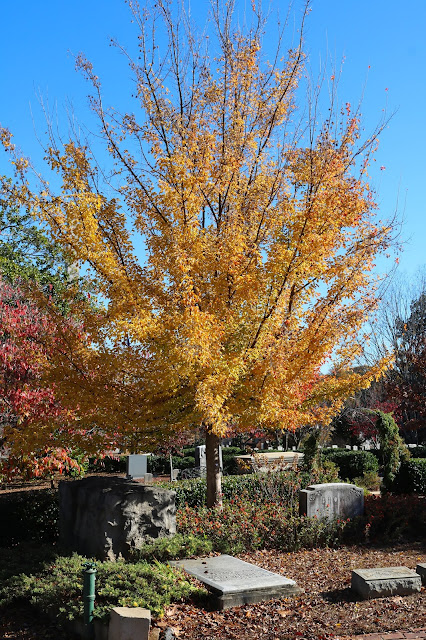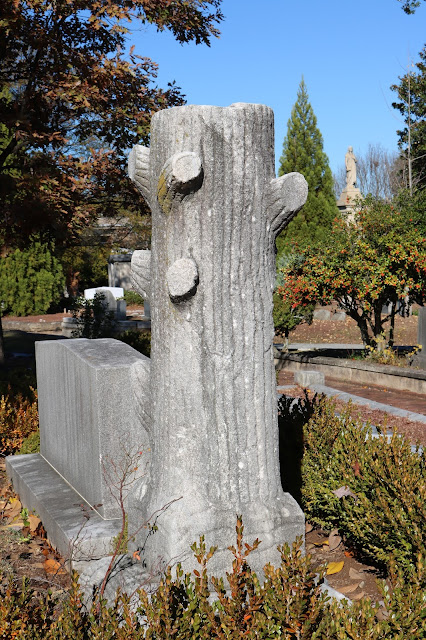I See Dead People: A Visit to the Historic Oakland Cemetery, Atlanta
When I moved to Scotland at the end of June, I promised my Mom that I would come back for Thanksgiving. So on November 17, I flew from Edinburgh to Jacksonville for a 20-day visit with family and friends. It was a nice visit, although I wasn't able to catch up with everyone.
After I spent time visiting Mom, I returned to Jacksonville for a week with my friend, Christa. We traveled up to Atlanta, Georgia, to visit with my daughter, Andrea. Whilst there, we spent a couple of hours in the lovely Oakland Cemetery.
The City of Atlanta established a cemetery on the site in 1850. It adopted the name Oakland Cemetery in 1872 because of the large amount of oak trees throughout the property. The area is beautiful and is apparently a popular place for people to take a stroll and enjoy the park-like setting. The cemetery covers forty-eight acres. It was developed in the style of the rural cemetery movement (I didn't even know there was such a movement). A sign notes that "Oakland is an example of the Victorian interest in funerary art and English landscape aesthetics."
Atlanta enjoyed/endured a long summer, so autumn foliage came quite late. We visited on the first day of December and were treated to some glorious fall colors.
I noticed what I presumed to be Masonic symbols on this gravestone. I was intrigued by the links with the letters F, L, and T within them.
Nearby, I spotted this gravestone with a slightly different linked FLT. Of course I Googled it before I wrote this blog. The symbol denotes membership in the Independent Order of Odd Fellows, a non-political fraternity, whose motto is Friendship, Love, and Truth.
I think I was just as fascinated by the fall foliage as I was with the gravestones,
This cenotaph marks the entrance to the section for Confederate graves. There is a Union section, as well, but we did not come across it.
A tiny, and I do mean tiny, portion of the Confederate graves. Some of the graves are of Confederate soldiers who were from Atlanta, but it seemed that most were of those who died in Atlanta hospitals.
Like this man from Alabama. He was wounded at the Battle at Chickamauga in September 1863 and died in Atlanta a couple of weeks later.
Some more Confederate gravestones.
What I think was most striking about the cemetery is the artistry of the older graves.
I was trying to get artsy here. I liked the play of the brilliant red of the one bush against the dark green of the other with the fancy bench in the foreground. I frame photos in my head and sometimes, like with this one, the end product isn't as nice as what I imagined.
I was getting a bit artistic here, too. I was struck by how the white mausoleum seemed to glow in the sunlight, whilst just about everything around it was shrouded in shade.
We had a heckuva time finding this gravestone. This was the one famous person I wanted to see here. The online maps were of little help, especially since the image people posted of it were not the right headstone! But Christa found it. This is the final resting place of Margaret Mitchell, the author of Gone With the Wind. I did not realize she died so young.
What a unique headstone! I can only assume that Benjamin Crane, who was a Mason (Can you see the symbol?) was somehow connected to the lumber industry.
The craftsmanship was very impressive.
There are several family plots in the cemetery. Apparently, this was a much loved mockingbird.
I know that women were considered the lesser sex in the 19th Century. They had no rights, couldn't vote, etc. I understand that was the societal norm during this time, and I don't usually judge them for it. So when I see a gravestone that says something like, Mary Smith, beloved wife of John Smith, I don't flinch. But this pair of headstones caught my attention. First, there's the style difference. We have this grand pillar for John Turner, and a small, albeit ornate, headstone for his wife. But what really got to me was . . . .
His wife didn't even get a name! This one left me gobsmacked.
Some late blooming flowers caught my eye. The wee bug enjoying the nectar was a plus.
We visited this area of the cemetery because Christa noticed the headstones were more condensed. It turns out it was the Jewish section. Many of them were written in Hebrew.
Naturally, my first thought when I saw this headstone was Star Trek. I then remembered reading an article in which Leonard Nimoy, who played Spock, said he was inspired by the blessing gesture used by rabbis when he created the Vulcan "Live Long and Prosper" salute.
The Jewish section was adjacent to the Confederates. So here's a snap from the other end. Like I said, it's huge.
It was sad seeing so many headstones for children. We came upon one family plot where every child died before the parents. This little boy didn't even have a name.
I loved the look of this unusual tree. I don't know what it is, but its textures are fascinating.
Here's a closer look of the cream-colored berries against the feathery bare branches.
Grabbing a shot of the sun shining through the autumn leaves.
No offense to Mrs. Compton, but I'm glad the city was renamed Atlanta.
I took a final shot before we made our way back to the car. I suppose it's strange to say I had fun at a cemetery, but it's the truth. It was a beautiful day in a beautiful setting where we saw true artistry and got a taste of history. To me, that's a great way to spend a couple of hours.
After I spent time visiting Mom, I returned to Jacksonville for a week with my friend, Christa. We traveled up to Atlanta, Georgia, to visit with my daughter, Andrea. Whilst there, we spent a couple of hours in the lovely Oakland Cemetery.
The City of Atlanta established a cemetery on the site in 1850. It adopted the name Oakland Cemetery in 1872 because of the large amount of oak trees throughout the property. The area is beautiful and is apparently a popular place for people to take a stroll and enjoy the park-like setting. The cemetery covers forty-eight acres. It was developed in the style of the rural cemetery movement (I didn't even know there was such a movement). A sign notes that "Oakland is an example of the Victorian interest in funerary art and English landscape aesthetics."
Atlanta enjoyed/endured a long summer, so autumn foliage came quite late. We visited on the first day of December and were treated to some glorious fall colors.
I noticed what I presumed to be Masonic symbols on this gravestone. I was intrigued by the links with the letters F, L, and T within them.
Nearby, I spotted this gravestone with a slightly different linked FLT. Of course I Googled it before I wrote this blog. The symbol denotes membership in the Independent Order of Odd Fellows, a non-political fraternity, whose motto is Friendship, Love, and Truth.
I think I was just as fascinated by the fall foliage as I was with the gravestones,
A tiny, and I do mean tiny, portion of the Confederate graves. Some of the graves are of Confederate soldiers who were from Atlanta, but it seemed that most were of those who died in Atlanta hospitals.
Like this man from Alabama. He was wounded at the Battle at Chickamauga in September 1863 and died in Atlanta a couple of weeks later.
Some more Confederate gravestones.
What I think was most striking about the cemetery is the artistry of the older graves.
I was trying to get artsy here. I liked the play of the brilliant red of the one bush against the dark green of the other with the fancy bench in the foreground. I frame photos in my head and sometimes, like with this one, the end product isn't as nice as what I imagined.
I was getting a bit artistic here, too. I was struck by how the white mausoleum seemed to glow in the sunlight, whilst just about everything around it was shrouded in shade.
We had a heckuva time finding this gravestone. This was the one famous person I wanted to see here. The online maps were of little help, especially since the image people posted of it were not the right headstone! But Christa found it. This is the final resting place of Margaret Mitchell, the author of Gone With the Wind. I did not realize she died so young.
What a unique headstone! I can only assume that Benjamin Crane, who was a Mason (Can you see the symbol?) was somehow connected to the lumber industry.
The craftsmanship was very impressive.
There are several family plots in the cemetery. Apparently, this was a much loved mockingbird.
I know that women were considered the lesser sex in the 19th Century. They had no rights, couldn't vote, etc. I understand that was the societal norm during this time, and I don't usually judge them for it. So when I see a gravestone that says something like, Mary Smith, beloved wife of John Smith, I don't flinch. But this pair of headstones caught my attention. First, there's the style difference. We have this grand pillar for John Turner, and a small, albeit ornate, headstone for his wife. But what really got to me was . . . .
His wife didn't even get a name! This one left me gobsmacked.
Some late blooming flowers caught my eye. The wee bug enjoying the nectar was a plus.
Why are there banana trees in an Atlanta cemetery? I tried to see if the headstone offered a clue, but it was badly worn away. Did he own a plantation on one of the Caribbean islands? Did he just really love bananas?
Naturally, my first thought when I saw this headstone was Star Trek. I then remembered reading an article in which Leonard Nimoy, who played Spock, said he was inspired by the blessing gesture used by rabbis when he created the Vulcan "Live Long and Prosper" salute.
The Jewish section was adjacent to the Confederates. So here's a snap from the other end. Like I said, it's huge.
It was sad seeing so many headstones for children. We came upon one family plot where every child died before the parents. This little boy didn't even have a name.
I loved the look of this unusual tree. I don't know what it is, but its textures are fascinating.
Here's a closer look of the cream-colored berries against the feathery bare branches.
Grabbing a shot of the sun shining through the autumn leaves.
No offense to Mrs. Compton, but I'm glad the city was renamed Atlanta.
I took a final shot before we made our way back to the car. I suppose it's strange to say I had fun at a cemetery, but it's the truth. It was a beautiful day in a beautiful setting where we saw true artistry and got a taste of history. To me, that's a great way to spend a couple of hours.













































Comments
Post a Comment